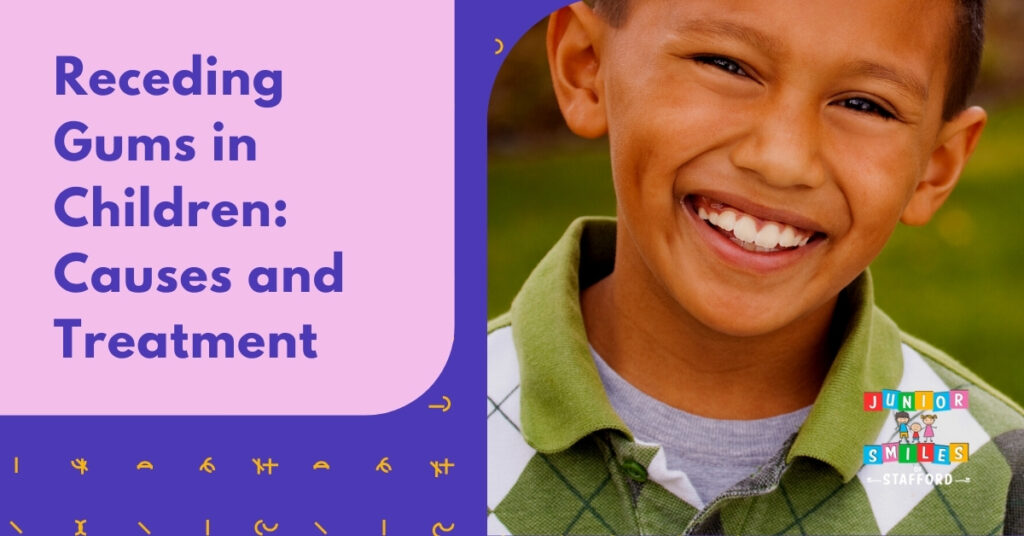Understanding and Addressing Receding Gums in Children

When parents check their children’s teeth, cavities are usually at the top of the list. However, gum recession, which is more often seen in individuals over 40, can start showing up in children as young as 10 years old. Unfortunately, most kids with receding gums don’t realize it’s a treatable dental issue.
The process of the gum tissue behind the teeth receding or wearing away is called gum recession. The teeth become more sensitive to temperature changes and more vulnerable to damage as the gum line recedes. Due to the growth of crevices between the gums and teeth, gum recession can significantly raise the possibilities of bacterial infection, tooth decay, and premature tooth loss. Learn more about gum recession, its symptoms, and how to avoid them in this in-depth blog post.
Can Children Get Receding Gums?
Many parents are surprised to learn that children, including teenagers, can indeed experience receding gums. Parents might notice their child’s bottom gums receding, especially around the bottom front teeth gums, which is a clear sign that a dental check-up is needed. In some cases, issues like gum growing over the front tooth of their child can be observed, which further highlights the need for attention to pediatric dental health. It’s crucial to address these early symptoms to prevent progression and ensure the long-term well-being of the child’s oral health.
Early Gum Recession Signs
Gum recession, a dental condition often associated with aging, can actually begin at a much earlier age than most people realize. Recognizing the early signs of gum recession is crucial for timely intervention and treatment. Here are some key indicators to watch out for:
Sensitive Teeth
One of the most common symptoms of early gum recession is increased tooth sensitivity. This happens because the receding gums expose the more sensitive parts of the tooth, especially near the gum line, resulting in discomfort when consuming hot, cold, or sweet foods and drinks.
Visible Roots
The exposure of tooth roots is a clear early sign of gum recession. This occurs when gums retract, revealing the parts of the teeth that are usually covered. Visible roots not only change the appearance of your kid’s smile but can also lead to increased tooth sensitivity.
Receding Gums on Front Tooth
Gum recession often starts with the front teeth. You might notice your child’s front teeth gums receding, making the teeth look longer than normal. This is particularly concerning because the front teeth are more visible and integral to their smile.
Bleeding After Brushing or Flossing
If your gums bleed easily during or after brushing and flossing, it’s a sign that your gums are not in optimal health. This can be an early indicator of receding gums and should prompt a dental check-up.
Loose Teeth
As gums recede, they can lose their grip on the teeth, leading to tooth mobility. Loose teeth are not just a sign of receding gums but also an indicator of potential bone loss in the jaw, which can have serious implications if left untreated.
Small Pockets or Gaps
The development of small pockets or gaps between your child’s teeth and gums is a concerning sign. These pockets can trap food particles and harbor bacteria, further exacerbating gum recession and potentially leading to periodontal disease.
Causes of Receding Gums in Children
Several things might cause gums to recede. Makeup of the genes is one of these. Gingival recession is a hereditary condition that can affect offspring of parents with the condition. Cases like these tend to be common, and they’re also very simple to identify and cure. However, you and your kid may be more prone to periodontitis, which can lead to gum recession. Periodontal disease is another cause of receding gums. Neglected gum disease caused by bacteria can rapidly recede the gum line around front teeth. As a result of the infection’s impact on the gums, teeth may become loose or even fall out of their dental sockets. Another possible cause of gum recession in your child might be their dental hygiene practice. Because it loosens and hurts the gums, vigorous brushing also loosens and hurts the teeth. Not to mention that recession can set in if your child grinds their teeth frequently, which stunts their gum and tooth development.
Treatment for Receding Gums in Children
Gum recession in children, while concerning, is often treatable with the right approach. Here are several effective treatments that can help manage and reverse gum recession in young patients:
Improved Oral Hygiene Practices
The cornerstone of treating receding gums in children is enhancing their oral hygiene. This involves teaching proper brushing techniques to avoid receding gums from brushing too hard and ensuring regular flossing. A pediatric dentist can provide guidance on the right toothbrush and techniques to use, especially important for receding gums on the bottom front teeth.
Regular Dental Check-ups
Regular visits to a pediatric dentist are essential for monitoring and managing receding gums in teenagers and younger children. These check-ups allow for early detection of potential issues like early receding gums and help in providing timely interventions. A dentist can also offer personalized advice and treatment plans based on the specific pattern of recession.
Desensitizing Agents
For children experiencing sensitivity due to receding gums, desensitizing agents can be applied to the affected areas. These agents help reduce sensitivity by blocking the pathways that transmit pain from the tooth surface to the nerves. This treatment is particularly helpful for children with receding front teeth gums where sensitivity can be more pronounced.
Gum Graft Surgery
In a bad gum recession, gum graft surgery might be recommended. This involves taking tissue from another part of the mouth and attaching it to the affected area to cover exposed roots. This procedure can be effective for receding bottom gums and helps in preventing further recession and tooth decay.
Orthodontic Treatment
Sometimes, misaligned teeth can contribute to gum recession. In such cases, orthodontic treatment like braces can help in realigning the teeth, thereby reducing the strain on the gums. This is particularly beneficial for issues like bottom front teeth gums receding due to crooked teeth.
When to See a Professional
Knowing when to seek professional help is crucial in managing and treating receding gums in children. If you notice any signs of gum recession or if your child complains about sensitivity around their gums or teeth, then it’s time to consult a dentist. Other red flags include visible changes in the gum line and any discomfort or bleeding during brushing or flossing. These symptoms can indicate the onset of gum issues and require prompt attention. A dental professional can accurately diagnose the problem, whether it’s early receding gums or more advanced issues, and recommend appropriate treatment. It’s especially important to act quickly if you observe bad gum recession or if your child expresses persistent discomfort around their gums. Early professional intervention can prevent the condition from worsening and help maintain your child’s oral health in the long run.
Preventive Measures for Receding Gums
Preventing receding gums in children starts with instilling good oral hygiene habits. Teaching children the correct way to brush, particularly ensuring they don’t brush too hard is fundamental. It’s also important to educate children about the importance of flossing and using fluoride toothpaste to strengthen teeth and gums. Diet also plays a significant role; reducing sugary and acidic food intake can safeguard against early gum recession and promote overall oral health. For children who are active in sports, wearing a mouthguard can prevent gum injury, which might lead to receding gums. Most importantly, always have a regular dental check-up for your kid as it is crucial for early detection and management. By taking these preventive steps, parents can help ensure their children’s gums remain healthy, reducing the likelihood of receding gums in teenagers and later in life.
Receding Gums in Children FAQs
Do Kids’ Gums Regrow?
In children, the gums do not “regrow” in the same way that some tissues in the body can heal and regenerate. The good news is that gum recession may be stopped in its tracks and gum health can improve with the right therapy. Teaching youngsters to use a soft-bristled brush softly will avoid additional harm to their gums if forceful brushing is the cause of receding gums. Early gum recession can be treated with dental procedures like cleanings or gum grafts to bring back healthy gums. So, parents should keep an eye on their children’s dental health and consult a dentist if they spot any signs of receding gums.
Why Are My Child’s Gums Receding?
There are several reasons why your child might be experiencing receding gums. One common cause is poor oral hygiene, which can lead to gum disease and, consequently, gum recession. Misaligned teeth or a misaligned bite can also put extra pressure on the gums and bones, which also leads to receding gums. Other factors include genetic predisposition, hormonal changes, especially in teenagers, and certain medical conditions. It’s essential to consult a dentist to determine the exact cause of receding gums in children and get appropriate treatment.
When Should You Worry About Receding Gums?
It’s time to worry about receding gums when you notice visible signs or symptoms that indicate worsening oral health. These include increased sensitivity in the teeth, particularly near the gum line, visible roots of the teeth, or changes in the appearance of the gums. If your child complains of discomfort while eating or brushing, or if you notice bleeding during oral care routines, these could be signs of early gum recession. Additionally, if you observe receding gums in your teenagers or younger children, it’s a clear signal to consult a dental professional. Early intervention is key to preventing further damage and ensuring the long-term health of your child’s teeth and gums.
Secure Your Child’s Gum Health with Junior Smiles
Understanding and addressing receding gums in children is vital for their long-term oral health. This blog post has highlighted the importance of recognizing early signs of gum recession, exploring its causes, and discussing various treatment options available. As a parent, staying vigilant about your child’s dental health and taking preventive measures can make a significant difference in preventing and managing this condition. Remember, receding gums can affect children as young as ten years old, so early intervention and regular dental check-ups are key.
If you’re concerned about your child’s gum health or have noticed any signs of receding gums, it’s time to turn to the experts. Junior Smiles of Stafford is your trusted dental clinic specializing in pediatric dentistry. Our team of experienced professionals is dedicated to providing the best care for your child’s dental needs. From routine check-ups to specialized treatments for receding gums, we ensure a comfortable and caring environment for your child. Don’t wait for the symptoms to worsen. Schedule an appointment with us today and take the first step towards safeguarding your child’s smile.

